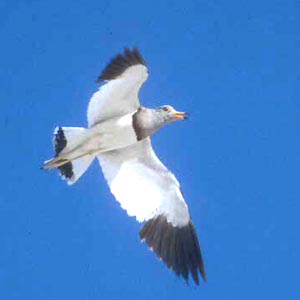
a web page by Don Roberson |
PLOVERS Charadriidae Plovers, Lapwings, Dotterels & allies |
|||
|
|||
This (left) is Pied Lapwing, a small lapwing that is associated with tropical sandbars in the wider Amazonian Basin in South America. It is primarily sedentary and looks about the same at all times. Likewise, the colorful Inland Dotterel of Australia (below) does not have markedly different plumages. It likes flat, open, arid habitats, often on gravel or gibber plains, but disperses with droughts or heavy rains. |
|||
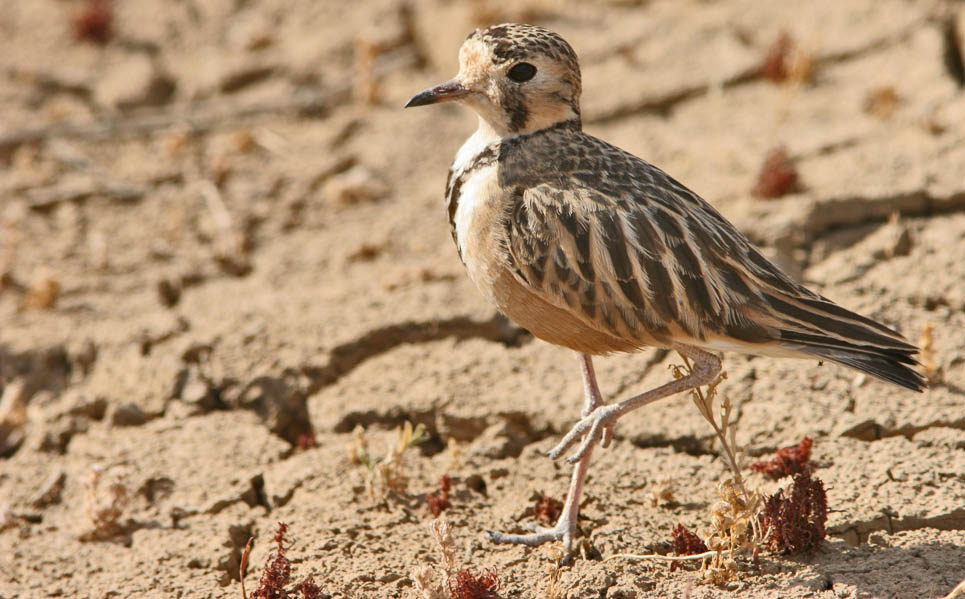 |
|||
In Monterey County, California, where I live, nests must be actively protected and guarded for any success at all. Not only are people the problem, but so are non-native predators (such as Red Fox) or even range expansion in populations of Common Raven. Our local populations have been intensively studied; e.g., Warriner et al. (1986), Stenzel et al. (1994). |
|||
All plovers hatch precocial young that can feed for themselves, but "parental care consumes considerable time . . . that can be partitioned into three components:" teaching the chicks about dangers through a high level of diligence and communication; leading, following, and gathering young; and brooding. This parental care continues until the young can fly. Cryptic coloring is very helpful in protecting precocial babies; a nice example is shown in this very young Killdeer (below). |
|||
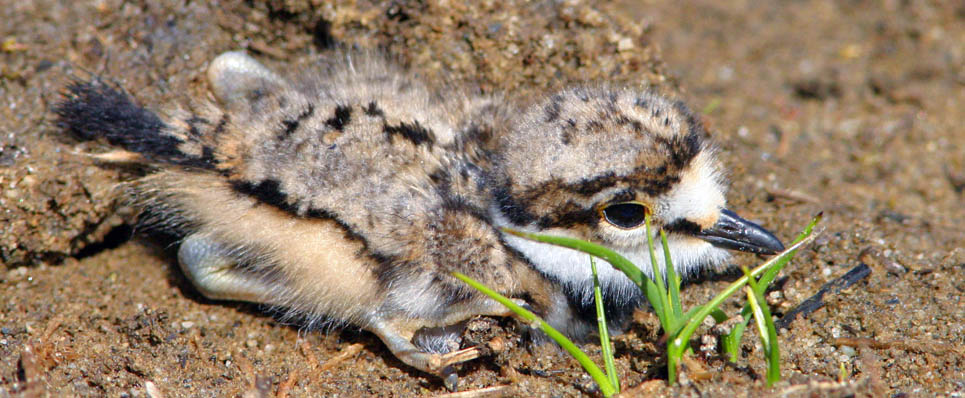 |
|||
 |
|||
Northern and Arctic-breeding species are highly migratory and thus capable of migratory mistakes, bringing vagrants to brighten the lives of birdwatchers. About half the California list of plovers are of such vagrants — highly sought after and (sometimes) difficult to identify. In the panel (above), a horde of birders clump together on the muddy shore of a wetland in Davis, California, staring through their scopes at a breeding-plumaged adult Common Ringed Plover. Common Ringed Plover is an abundant species across much of the Old World but here, in California, it is the first ever to be found in the State. It is difficult to separate from the New World species Semipalmated Plover C. semipalmatus, but articles like Dunn (1993) are helpful, and yes, one does need to determine the presence/absence of webbing between the inner toes. . . . There are now about a dozen California records of Lesser Sand-plover over the years since the State's first in 1980; still, that averages only about one every 3 years. So it is a glamour vagrant. That adult male (below) sits on the ocean beach at Pajaro Dunes, with the pounding surf in the background. |
|||
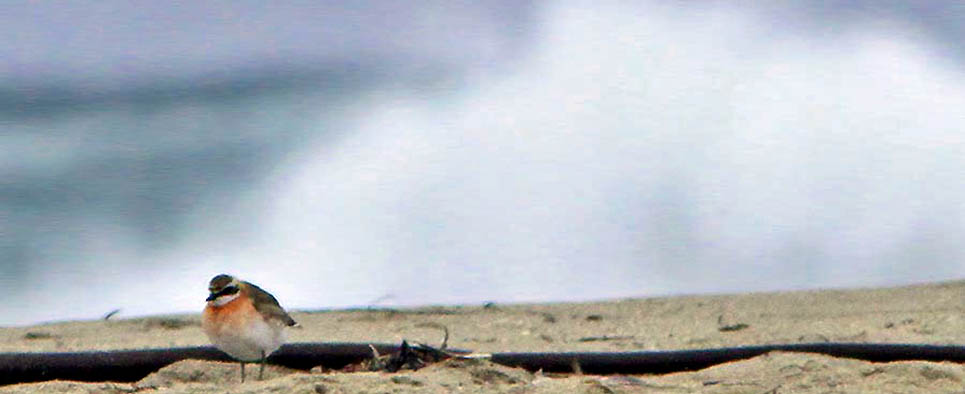 |
|||
 |
|||
Whatever may be the eventual answer as to one or two "plover" families, the four "golden-plovers" [3 species called golden-plovers plus Black-bellied Plover] are a distinctive set of birds. All are highly migratory and their breeding plumage is strikingly different than the plumage worn on the wintering grounds. An American Golden-Plover on its arctic breeding grounds is spectacular (as in this photo by Tom Grey, right). It colorful upperpart pattern serves a camouflage when sitting on a nest among the colorful tundra. Black-bellied Plover (four shown above on migration in July) lacks the gold in the plumage but is also extensively black below in breeding plumage. These four show a range of molt — from a couple that still have much alternate plumage to one (uppermost right in above photo) that is almost entirely into its gray-and-white winter dress. Americans use the name Black-bellied Plover for this species but English-speaking birders in the Old World use the British name "Grey Plover" — but we're all talking about the same bird, just emphasizing a different plumage. As all the "golden-plovers" are migratory, they can spin off vagrants around the globe, and created field identification problems. Papers that address i.d. or speciation issues include Connors (1983), Connors et al. (1993), Pym (1982), and Roselaar (1990). Pacific Golden-Plover (below), shown here bathing in its still-colorful juvenal plumage on its Hawaiian wintering grounds, is a champion long-distance migrant. One project tagged 24 birds on the Hawaiian winter grounds with transmitters, and followed them to their breeding grounds in Siberia and Alaska. On spring migration averaged 63 kilometers per hour [=40 miles per hour] and traveled 4800 kilometers [~3000 miles] in three days. They made the autumn return trip in about four days (Johnson et al. 2011). And those were just the ones wintering in Hawaii. Pacific Golden-Plovers winter on small islands across the South Pacific, and all the way south of New Zealand. I recall days in October 1989, when I was the seabird observer on a NOAA research cruise thousands of miles offshore in the eastern tropical Pacific, when Pacific Golden-Plover was the most common species encountered during the entire day! Those were golden-plover on their fall flight south across the Pacific. The research shows they use direct routes and are extremely accurate in their navigation. |
|||
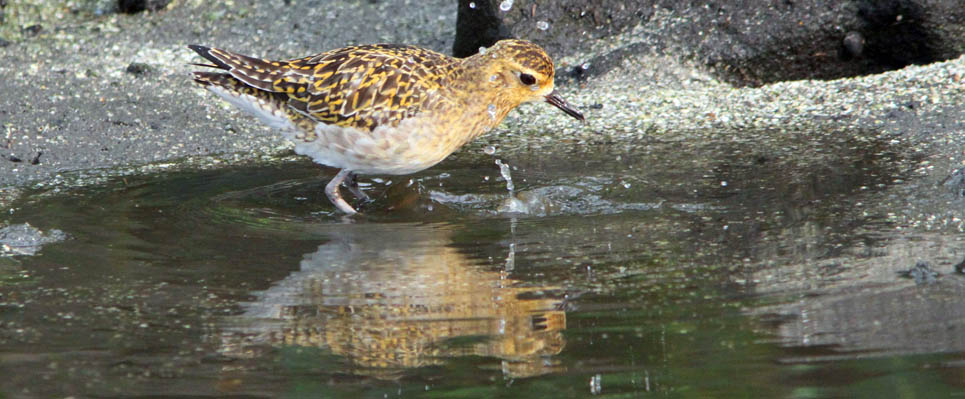 |
|||
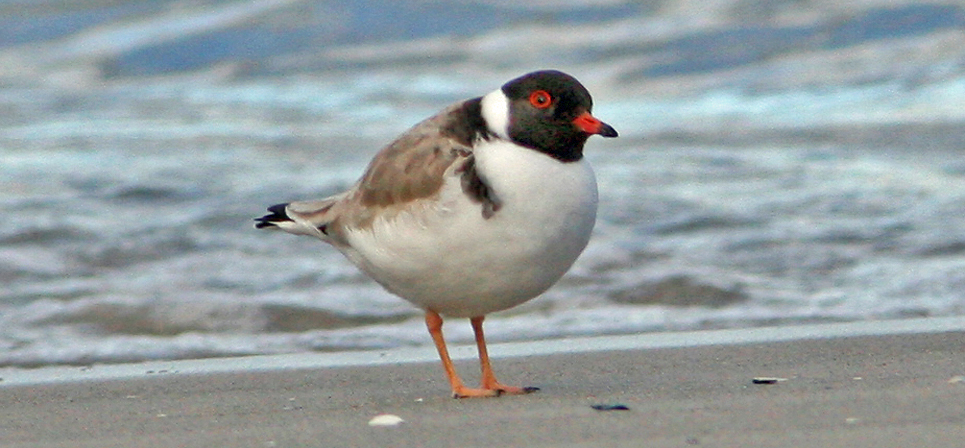 |
|||
Even more strange is the Diademed Plover (left, in a photo by Chris Carpenter) of high Andean bogs from Peru south to the borderlands between Chile and Argentina. Its old name was "Sandpiper-plover" because its bill is very unlike all the other plovers. The Wrybill Anarhynchus frontalis of New Zealand also has a very odd bill — long, slim and straight except at the tip, which is decidedly curved to the right — but otherwise seems 'plover-like' in body shape (plump, short legs) and behavior. |
|||
Black-headed Lapwing (right) is a good example — brilliantly dapper in black-and-white-and-tan, it seems to exude 'personality.' This one in northern Ghana was foraging on a recently burned patch of grassland. A number of plovers seem to gravitate to such situations. Gray-headed Lapwing (below left) is a large, long-legged, colorful, migratory lapwing of eastern Asia. This one is flying over us and scolding, presumably as we were too close to to nest. It breeds in north-east China and migrates to south Asia for the winter. |
|||
|
|||
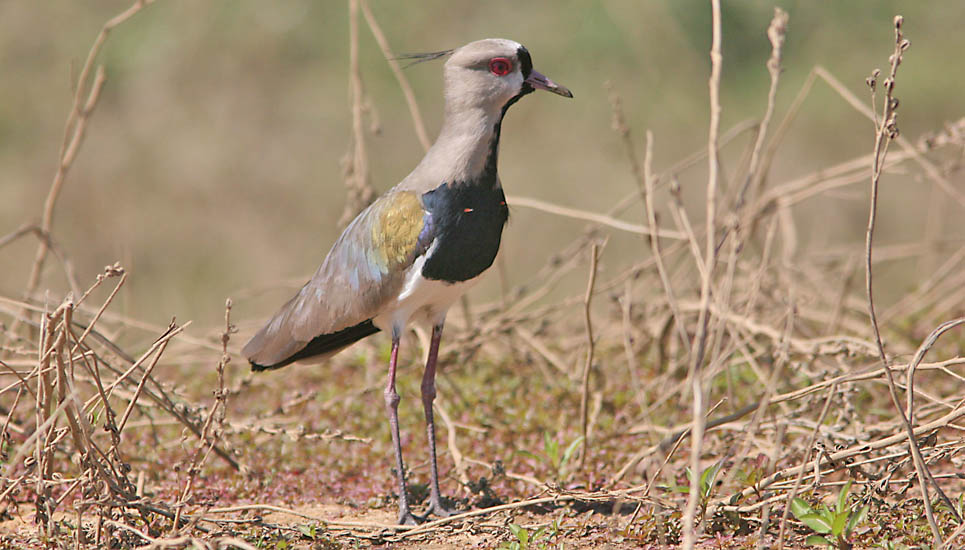 |
|||
Photos: The Pied Lapwing Vanellus cayanus was along the Cuiba River in the Brazilian Pantanal on 20 July 2010. The Inland Dotterel Peltohyas australis was on 20 Nov 2009. The Snowy Plover Charadrius novosus was at the Pajaro R. mouth, Monterey Co., on 7 Aug 2016 (it had picked up a moth). The adult Killer Charadrius vociferus was near Salinas, CA, on 21 June 2008, and the precocial young was at the Salinas R. mouth on 23 Apr 2007. The Common Ringed Plover Charadrius hiaticula was at the Davis wetlands, Yolo Co., CA, on 21 Aug 2011. The Lesser Sandplover Charadrius mongolus was at Pajaro Dunes, Santa Cruz Co., CA, on 4 Aug 2013. The four Black-bellied Plover Pluvialis squatarola were at Pebble Beach, Monterey Co., CA, on 26 July 2014. Tom Grey photographed the American Golden-Plover Pluvialis dominica on the Canadian breeding grounds. The Pacific Golden-Plover Pluvialis fulva was at Pu'uhonua o Hna'unau National Historical Park on the "Big Island," Hawaii, on 1 Jan 2012. The Hooded Plover Charadrius rubricollis was near Orford, Tasmania, Australia, on 21 Aug 2008. Chris Carpenter photographed the Diademed Plover Phegornis mitchellii in southern South America in the 1990s (digitized from a slide back then). The Black-headed Lapwing Pluvialis tectus was at Tono Dam in north Ghana on 15 Dec 2013. The Gray-headed Lapwing Vanellus cinereus was in Xianghai NNR, Jilin (previously Manchuria), China, on 12 June 2004. The Spurwing Plover Vanellus spinosus was Huleh Reserve, Israel, in Oct 1981. The Southern Lapwing Vanellus chilensis was at at Cuiaba, Brazilian Pantanal, on 22 July 2010. Uncredited photos © Don Roberson. Credited photos © Tom Grey and © Chris Carpenter, as credited, and used with permission; all rights reserved. Family book:
Literature cited:
|
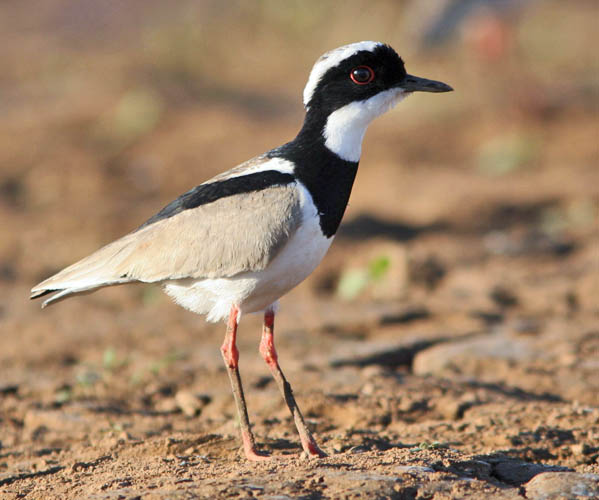 Plovers
occur throughout the world. They are readily distinguished from
sandpipers and allies, primarily by a standard "plover-like" bill in
most species. Normally associated with open wetlands or fields, they
occur from the high arctic tundra to tropical sandbars to desert
grasslands. Migratory plovers, like the golden-plovers, generally have
a bright alternate plumage worn on nesting grounds while tropical
plovers tend to look the same year-round.
Plovers
occur throughout the world. They are readily distinguished from
sandpipers and allies, primarily by a standard "plover-like" bill in
most species. Normally associated with open wetlands or fields, they
occur from the high arctic tundra to tropical sandbars to desert
grasslands. Migratory plovers, like the golden-plovers, generally have
a bright alternate plumage worn on nesting grounds while tropical
plovers tend to look the same year-round. 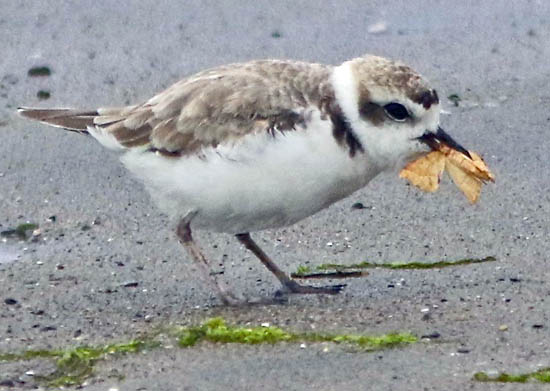 More familiar to many observers are the smaller plovers of ocean or lake sores, such as this Snowy Plover (left). It has a wide range across (mostly) western North America; the very similar Kentish Plover C. alexandrinus
is widespread in the Old World. Despite its wide range, Snowy Plover is
a Threatened species in California, where its preferred coastal nesting
habitat are the same sandy beaches that are besieged by weekenders,
runners, picnickers, and their dogs. This habitat is also actively
sought by developers of coastal resorts.
More familiar to many observers are the smaller plovers of ocean or lake sores, such as this Snowy Plover (left). It has a wide range across (mostly) western North America; the very similar Kentish Plover C. alexandrinus
is widespread in the Old World. Despite its wide range, Snowy Plover is
a Threatened species in California, where its preferred coastal nesting
habitat are the same sandy beaches that are besieged by weekenders,
runners, picnickers, and their dogs. This habitat is also actively
sought by developers of coastal resorts. 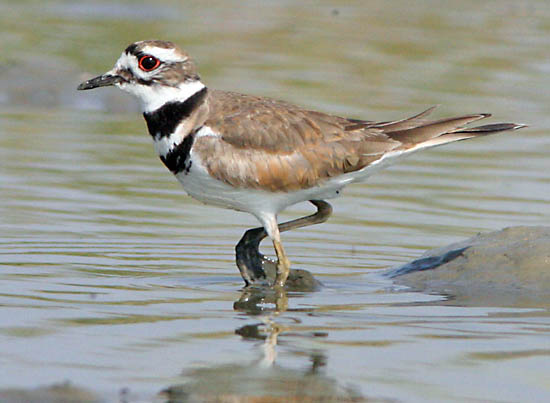 Another very familiar North American species is in the mid-sized, double-banded Killdeer
(right). It is very widespread along lake shores, open fields and flats
with short vegetation, sometimes not close to water at all. Its
familiar, blaring warning cry "kill-dee, kill-dee" often serves to warn other waders of danger, real or imagined.
Another very familiar North American species is in the mid-sized, double-banded Killdeer
(right). It is very widespread along lake shores, open fields and flats
with short vegetation, sometimes not close to water at all. Its
familiar, blaring warning cry "kill-dee, kill-dee" often serves to warn other waders of danger, real or imagined.  Some
molecular studies suggests the plovers all share a common ancestor
(e.g., Baker et al. 2013). [There are exceptions as to the enigmatic
Some
molecular studies suggests the plovers all share a common ancestor
(e.g., Baker et al. 2013). [There are exceptions as to the enigmatic 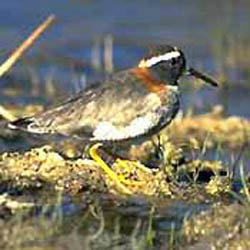 Among the odd and unusual plovers of the world is the Hooded Plover
(above) of southern Australia and Tasmania. It is plump, short-legged,
and looks 'neckless' as in runs along the sandy beaches at the edge of
the surf. The colorful red eye-ring and bill base make it look
'curious.'
Among the odd and unusual plovers of the world is the Hooded Plover
(above) of southern Australia and Tasmania. It is plump, short-legged,
and looks 'neckless' as in runs along the sandy beaches at the edge of
the surf. The colorful red eye-ring and bill base make it look
'curious.' 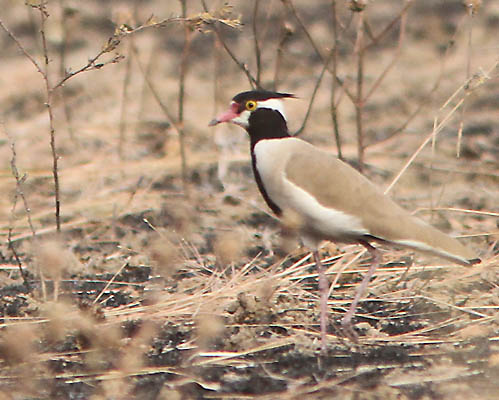 There
are quite a number of wonderful lapwings in Asia and Africa. I tend to
be impressive by crested birds in general, and if they are colorful or
striking, so much the better!
There
are quite a number of wonderful lapwings in Asia and Africa. I tend to
be impressive by crested birds in general, and if they are colorful or
striking, so much the better! 